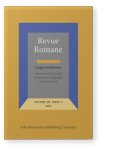Vol. 56:2 (2021) ► pp.297–326
El futuro morfológico en las lenguas iberorromances
Temporalidad, modalidad y evidencialidad
The future tense in the Ibero-Romance languages swings between temporal and modal readings. Despite the fact that all the varieties of the Iberian Peninsula possess various strategies that compete with the morphological future, there is no consensus on pinpointing which alternative refers to each of the possible readings. The only thing all authors agree on is the current decline of the morphological future tense with temporal value. In this article, current dialect data of the Romance languages of the Iberian Peninsula have been collected with the aim of analysing the contemporary and oral usage of this verbal tense in order to verify whether it still maintains its temporal or modal uses, or whether, as the latest research points out, it has become an evidentiality strategy.
Article outline
- 1.Introducción
- 2.Corpus y metodología
- 3.Resultados y análisis
- 3.1Distribución geográfica y lingüística
- 3.2Valores semánticos
- 3.3Evolución
- 4.Conclusiones
- Expresiones de gratitud
-
Referencias
Article language: Spanish
